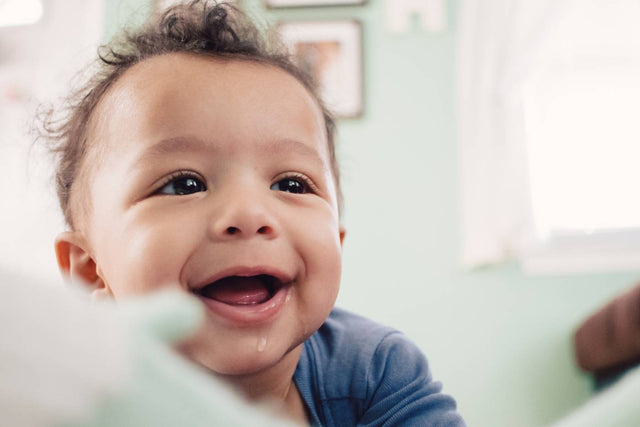The Truth About Amber Teething Necklaces and Other Teething Myths

If you’ve ever stayed up late at night with a crying baby who was busy cutting their first tooth, then you know that you’d probably do anything to calm your little one down. Teething can be a ferocious beast for everyone involved…but it can go a little more smoothly if you know how to separate fact from fiction when it comes to caring for your baby’s unhappy gums. Before reaching for any old remedy, make sure you brush up on these common teething myths.
Teething Myths to Stop Believing
Teething Myth #1: Amber teething necklaces stop teething pain.
Amber necklaces—and any other teething product that is meant to be worn around the neck—are not safe and do not stop teething pain. Some folks swear that amber has a special quality that can pull out the pain of sore gums. The truth is that there is no scientific backing to this claim.
According to the myth, amber warms up against Baby’s skin and releases a natural pain-relieving chemical called succinic acid. In reality, the only way to get succinic acid to leech out of amber would be at very high temperatures of 400 degrees Fahrenheit or higher (in other words, lots hotter than your tot’s skin!). What’s worse, beads are a choking hazard, so giving a baby a beaded necklace that they may be tempted to pull on and put in their mouths can end tragically!
Teething Myth #2: Teething makes babies sick.
Many parents have observed that during teething their baby also had diarrhea, fever, or other maladies. It’s been thought that babies swallow excess saliva during teething that can cause diarrhea, and swollen gums may trigger a mild fever. But studies have shown that teething does not make babies sick. If your baby has a fever and/or diarrhea, it could mean your baby is battling something else, and that you should call your doctor to rule out an infection.
Teething Myth #3: The best teething pain-relief comes from a pharmacy.
It can be heartbreaking to watch as your child cries and for long periods of time because of teething. For this reason, some parents will head to the pharmacy to help soothe those painful baby gums any way they can. But be very cautious about what you choose to use. The Food and Drug Administration (FDA) recently warned parents about the use of belladonna, a natural herb that can relieve pain but can also be poisonous at the wrong dose. Topical treatments, can also pose more risk than reward, according to the FDA. Gels and creams that include Benzocaine, a local anesthetic, can be dangerous, and because they wash out of a baby’s mouth quickly, don’t work well.
Talk to your pediatrician about what methods of pain-relief are safe and effective. You may find that something as simple and safe as frozen wash cloth may be the best bet. (Pro tip: Dip a corner of a washcloth in apple juice and freeze it to entice your teething baby to gnaw away their pain.)
More Baby Teeth Myths
Once those chompers emerge, you’ve got to start taking care of them! Here’s how to sort fact from fiction when it comes to keeping your baby’s teeth healthy…
Teething Myth #4: Fluoride is dangerous for kids under 2.
Both the American Dental Association (ADA) and the American Academy of Pediatrics recommend that kids begin using fluoride toothpaste as soon as their first tooth appears. For little ones under 3, parents should use an amount of toothpaste at about the size of a grain of rice. Kids older than 3 should be taught to use an amount of toothpaste the size of a pea.
Teething Myth #5: Baby teeth don’t need to be brushed as often as adult teeth.
We know that plaque can develop a film strong enough to begin causing dental problems after 24 hours. For this reason dentists recommend that kids and adults brush every morning and every night to prevent plaque from building up enough to cause cavities and other problems.
Teething Myth #6: You don’t need a dentist until kids are at least 3.
As soon as the first tooth appears, parents should book a dentist appointment. This does two things: first it gives kids a very early exposure to dentists, which helps them to develop a healthy relationship with good dental hygiene. Second, early dental visits help parents to separate fact from fiction when it comes to taking care of their children’s teeth. Early education, developing solid dental hygiene habits, and having a positive attitude about dental care can go a long way to preventing cavities and other issues as children grow.
Teething Myth #7: Baby teeth don’t get cavities.
Baby teeth are no less vulnerable than adult teeth when it comes to the erosion effects of acid! Enamel on baby teeth is the same as on adult teeth, which means you’ve got to brush ’em the same way: twice a day with a fluoride toothpaste. While you’re at it, steer clear of sugary foods…especially before bed. As hard as it may be to wrestle a toothbrush around a wiggly Baby’s mouth, they’ll probably have a much tougher time getting cavities filled!
For more on baby and toddler dental health, check out these articles: